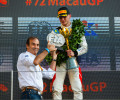From Auto #17: Drawing slide rules
Formula Drift President Jim Liaw on the process of regulating motor sport’s fast-growing underground discipline

Click here to read the full Auto #17 magazine.
Q Where is Drifting in its evolution from underground pursuit to mainstream motor sport discipline?
A Drifting pretty much exists in every market, in various forms. Definitely it exists in a grassroots form. There have been different spikes around the world that have escalated the sport – Formula Drift being one of them and the next phase is to push it towards a professional level as much as we can, to bring what is still a weekend sport into something that is a championship that can be commercially feasible.
There are some series that have had degrees of success but the next step is the legitimisation of this form of motor sport in order to find a cohesive global platform. We are fragmented in different parts of the world and there are certain rules we employ that don’t necessarily work in other parts of the world. That’s where we are now.
Q How difficult a process is that formalisation and in doing so is there a risk of diluting the spirit of the discipline?
A I look at it as being similar to skateboarding, or perhaps more so to snowboarding when it first hit ski resorts and it was met with some resistance by skiers. Snowboarding then became a formalised sport and went to the Olympics. Has that made the sport too mainstream? Did it lose some of that ‘street’ appeal? I don’t think it did but that’s the fine line we have to walk.
How difficult is that process? I don’t think it’s very difficult, because the world is such a small place. All of the major drifting series organisers have been in contact and whether we agree or disagree at the moment everyone is in contact. Thanks to the FIA’s initiative with the Drifting Working Group that process has accelerated and has enabled everyone to have one conversation about technical regulations, vehicle safety etc.
You see it in other forms of motor sport. Once you have a common set of regulations then you can take, for example, a GT3 car and race it in various series in other parts of the world. You can buy and sell it and work with a customer programme in various places but you are in the same space.
If we can do that, at least in terms of the commercial viability for up and coming team owners and businesses investing in the sport it will no longer be a case of building a car, racing it for a couple of years and then you are done. There will be a residual value and a solid future.
Q How important is it for Formula Drift to have this formalisation process happen?
A It’s important. Right from the beginning [formalisation] was one of our priority topics, so we are pretty up to speed on all of the latest FIA safety regulations.
FIA affiliation or global recognition for the sport will help us to get over another hurdle, which is the recognition of the sport as having a place in all things motor sport. That will give the sport a more serious perspective and it will make it an attractive investment opportunity for auto makers and it would allow us to potentially have works programmes.
Q You speak about making the category attractive to manufacturers. Does that carry a danger that affordability of entry – which has always been central to the spirit of drifting – will be undermined?
A I don’t think it will. It’s like any sport. The aspirational element – as in Formula 1 – has to be there and then there is a trickle-down effect to grassroots level.
If the pinnacle of a particular sport is not high enough then the amateur level may not expand. We want commercial success, we want works teams, we want young drivers to feel that there is progress to be made, that there is a career path, something to aspire to.
We want that a young driver is able to go to a track with a $10,000 car and win and then that he or she can see further potential to progress. We want teams to see potential in that driver and for there to be multiple steps on a ladder that will take them to that pinnacle.

 Facebook
Facebook Twitter
Twitter






